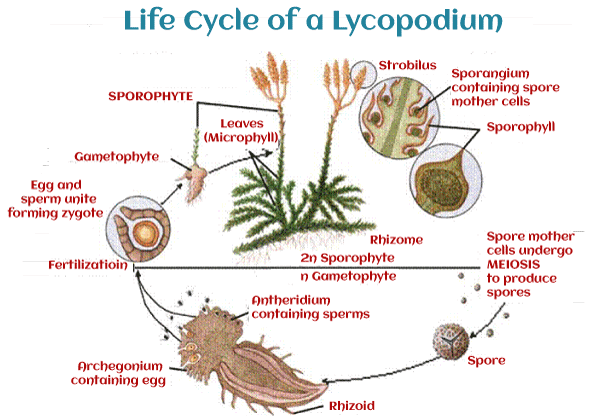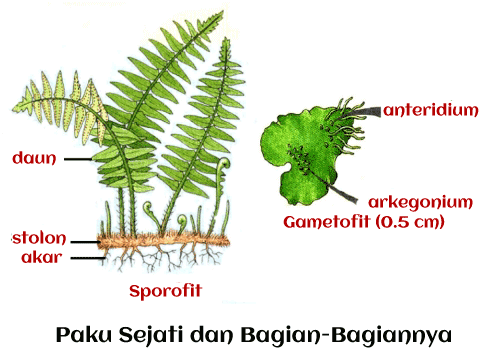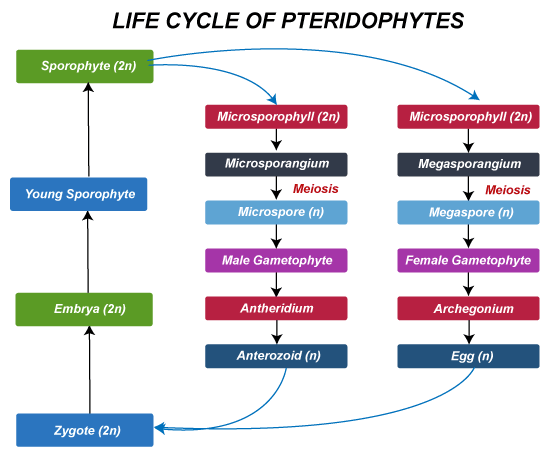What is Pteridophytes?
Hundreds of million years before, the whole landscape was covered with non-flowering plants that looked like ferns. These terrestrial vascular plants hold a transitional position between bryophytes and spermatophytes. In botany, scientist Carolus Linnaeus classified them as pteridophytes under the group crypto game.
Pteridophytes have more than 12000 species on earth with their ancestor’s characteristics. This word came from the Greek word Pteron (which means feather, phyton, and plants). Most plants of the plant kingdom reproduce through seeds, but pteridophytes reproduce through spores.
Basic examples of Pteridophyta are:-

History/ classification of pteridophytes
- Firstly, Eichler subgroups the plant kingdom into Cryptogamia and Phanerogamia.
- Cryptogamia was subdivided into three parts: Thallophyta, Pteridophytes, and Bryophyta.
- Bryophyta and Pteridophyta were grouped under Embrophyta.
- In 1935, Sinnott introduced a new term Tracheophyta, further divided into four parts.
- In 1936, Eames divided Tracheophyta into four parts: Sphenopsida, Psilopsida, Pteropsida, and Lycopsida.
- Psilopsida is described in three ways Gymnospermae, Angiospermae, and filicinae.
- Smith (a botanist) categorizes pteridophytes in these types:- Filicineae, Lycopodineae, equisetineae, and psilophytineae.
Categorization of Pteridophytes
These are categorized into four main classes by Oswald and Tippo in 1942.
a) Psilopsida
- These plants are most primitive, with rhizoids where leaves are absent. Their stem is dichotomously branched (small rhizoids come out from the rhizome). Examples of Psilopsida are Thelypteris and Psilotum.
- These are the oldest vascular plants which species are now fossil.
- Instead of roots, the underground rhizome is present and has an aerial shoot, which helps absorb water and salt.
- Leaves structures are spiral-like in Psilotum or leaf-like appendages, as is Tmesipteris.
- The sporangia exist directly on the stem(cauline in position) or the tip of the stem, and photosynthesis also happens on this.
- Gametophyte grows as a saprophyte with a fungus, and it is not photosynthetic because it doesn’t have chlorophyll (not in green color).
- In these, antherozoids are spirally coiled and flagellated.
b) Lycopsida
- Lycopsida is called club moss. Their sporophyte is present in two ways- homosporous or heterosporous. Lycopodium and Selaginella are two examples.
- The stem branching is dichotomous, and sporangia are present on the axil of sporophylls (arranged at strobila).
- The p
- lant body is defined among stem, root, rhinophores, and leaves.
- The gametophytes grow independently.
c) Sphenopsida
- These types of plants are homosporous, and sporangia grow on strobila.
- Another name is horsetail because roots arise from underground rhizome nodes, scaly leaves, and stems. For example- equisetum.
- The plant stem has different internodes and nodes, and they are arranged in whorls.
- Equisetum is the only living genus that is homosporous,
- Antherozoids have multiple flagella.
- Sporangia are formed in a special appendage called sporangiophore.
d) Pteropsida
- Pteropsida is the world’s largest group of pteridophytes, with more than 9000 species in the group.
- Ferns are the prominent members of this class that is found in different habitats, terrestrial, shady, damp places, underwater, and a few are epiphytes.
- These plants have a body with roots, leaves (arranged spirally), and stems. For example- Dryopteris, Pteris, and Adiantum.
- Thick and short rhizome and antherozoids are multiflagellate.
- They have homosporous or heterosporous sporophytes.
- Leaves of large size known as megaphylls (pinnately compound) are called fronds. These fronds are coiled in nature.
- Leaves also have sporangia at the margins and tip of the leaves (ventral sides of leaves) found in sori groups.

Some important characteristics of pteridophytes
1. Pteridophytes plants have a history of the first plant to be evolved on land:
According to the theories, it is assumed that life has begun under the oceans, and after the evolution of thousands of years, life started on dry land. The very first plant that lived on earth were pteridophytes.
2. Owner of multiple properties (cryptogams, seedless and vascular):
Pteridophytes plants consist of vascular tissue (but lack phloem cells and xylem vessels). These plants are seedless but reproduce through spores.
3. Pteridophytes plant have proper body structure:
Such plants have proper body structures like stems, leaves, and roots.
4. Reproduction through spores instead of seeds:
The sporangium is found on the tip of leaves that have two types of spores, and reproduction takes place when the spores are taken away by the wind.
Homosporous = One type of spore is produced.
Heterosporous = Two kinds of spores are produced.
5. Sporangia production termed as sporophylls:
Sporangia is present on leaves coined as sporophylls. Pteridophytes plant leaves have curls inwards to protect the vulnerable growing parts.
6. Multicellular sex organs:
Consist of both sex organs:- male organs called antheridia and female organs called archegonia.
7. True alteration of generation:
Two types of generation are observed in pteridophytes:-
Sporophyte generation (diploid generation)
Gametophyte generation (haploid generation)
Pteridophyta plant Life cycle
The life span of pteridophytes is slightly different from the mosses and seed plants as they show alternation of generations (saprophyte and gametophyte generation). The alteration in life span is known as metagenesis( diploid generation alteration with haploid generation).
Diploid generation – It’s the Saprophyte that produces the spores.
Haploid generation – It’s the Gametophyte that produces the gametes.
They both Saprophyte and Gametophyte perceive independence and free living.

About Saprophyte (diploid generation)
- It is a long and dominant phase than Gametophyte.
- Here reproduction takes place by the spores, produced by plants and carried away by the wind too far off.
- A process called meiosis is responsible for producing spores by the mother spore cell.
- Plants that produce similar pores are called homosporous, like lycopodium.
- Plants that produce different kinds of pores are called heterosporous. Two types of pores are produced named microspores and macrospores.
- These spores can germinate into the small Gametophyte (independently) under the favorable conditions called prothallus.
About Gametophyte (haploid generation)
- Small independent gametophytes called prothallus can grow in moist, cool, and shady places, but growth is restricted to a few.
- Gametophyte sexuality is classified as the following:-
- Protogynous= Here, the archegonia full-fledge grows before the antheridia.
- Dicicous = This Gametophyte can produce male antheridia (sperm) or female archegonia and egg cells.
- Monoicous = Single independent gametophytes produce both male antheridia and female archegonia (perform both male and female functions).
- Protandrous = In this phase, antheridia have fully grown before archegonia.
- They are both multicellular and photosynthetic
- Implement both male and female functionality.
- Zygote formation occurs by the fusion of sperm in antheridia with the egg in archegonia.
- The fertilized zygote further developed into a multicellular sporophyte.
Conclusion
Pteridophytes are the prominent and oldest plant species of the plant kingdom. These are still found in gardens and used as an ornament for decoration due to their bright green foliage.
For different purposes, species are used. For example:-
Selaginella for soil conservation and marsilea is a rich source of starch consumed by tribal.
Lycopodium clavatum – Used in treating skin ailments and used as a diuretic. Dryopteris – Utilized in making anthelminthic drugs and treating tapeworm infections.
After the bryophytes, Pteridophytes are the “snakes” of the plant kingdom as they were the first plant on the earth that crawled all over the earth (reproduce). Their different species are found on the earth; therefore, they are called “botanical snakes”.
